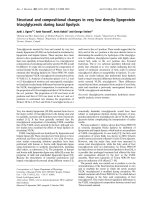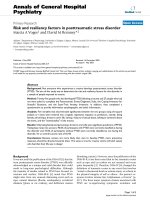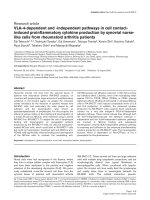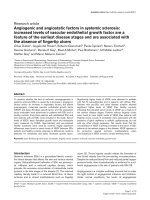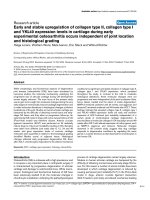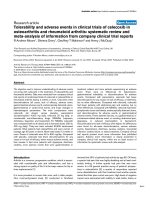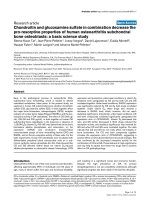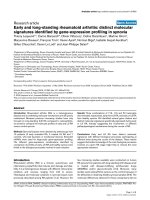Báo cáo y học: "VLA-4-dependent and -independent pathways in cell contactinduced proinflammatory cytokine production by synovial nurselike cells from rheumatoid arthritis patients" potx
Bạn đang xem bản rút gọn của tài liệu. Xem và tải ngay bản đầy đủ của tài liệu tại đây (212.04 KB, 8 trang )
Introduction
Nurse cells were first recognized in the thymus, where
they form a unique cellular complex with thymocytes [1,2]
and have been implicated in the positive and negative
selection of the developing thymocytes [3–6]. We previ-
ously established nurse-like stromal cell lines from the
synovial tissue of patients with rheumatoid arthritis
(RA-SNC) [7]. These stromal cell lines are large adherent
cells with multiple long cytoplasmic projections, and are
morphologically distinct from typical fibroblasts or
macrophage-like cells. When cocultured with lympho-
cytes, the stromal cell lines avidly bind the lymphocytes
and readily allow them to transmigrate beneath the
RA-SNC cells. This cellular interaction, pseudo-
bp = base pairs; BSA = bovine serum albumin; CS-1 = connecting segment-1; DMEM = Dulbecco’s modified Eagle’s medium; ELISA = enzyme-
linked immunosorbent assay; FCS = fetal calf serum; FITC = fluorescein isothiocyanate; IL = interleukin; mAb = monoclonal antibody; PBS = phos-
phate-buffered saline; PCR = polymerase chain reaction; RA = rheumatoid arthritis; RA-SNC = nurse-like stromal cell lines from the synovial tissue
of patients with rheumatoid arthritis; VCAM-1 = vascular cell adhesion molecule 1; VLA-4 = very late antigen-4.
Available online />Research article
VLA-4-dependent and -independent pathways in cell contact-
induced proinflammatory cytokine production by synovial nurse-
like cells from rheumatoid arthritis patients
Eiji Takeuchi
1,2,4
, Toshiyuki Tanaka
1
, Eiji Umemoto
1
, Tetsuya Tomita
2
, Kenrin Shi
2
, Koichiro Takahi
2
,
Ryuji Suzuki
3
, Takahiro Ochi
2
and Masayuki Miyasaka
1
1
Laboratory of Molecular and Cellular Recognition, Osaka University Graduate School of Medicine, Osaka, Japan
2
Department of Orthopaedic Surgery, Osaka University Graduate School of Medicine, Osaka, Japan
3
Research Unit of Immunology, Shionogi Institute for Medical Science, Shionogi & Co. Ltd, Osaka, Japan; current address: Pharmacology
Research Laboratories, Pharmaceutical Research Division, Takeda Chemical Industries Ltd, Osaka, Japan
4
Current address: Department of Orthopaedic Surgery, Osaka Rousai Hospital, Osaka, Japan
Correspondence: Masayuki Miyasaka (e-mail: )
Received: 26 June 2002 Revisions received: 4 July 2002 Accepted: 15 July 2002 Published: 12 August 2002
Arthritis Res 2002, 4:R10 (DOI 10.1186/ar593)
© 2002 Takeuchi et al., licensee BioMed Central Ltd (Print ISSN 1465-9905; Online ISSN 1465-9913)
Abstract
Nurse-like stromal cell lines from the synovial tissue of
patients with rheumatoid arthritis (RA-SNC) produce, on
coculture with lymphocytes, large amounts of proinflammatory
cytokines. In the present paper, we analyze the molecular
events necessary for the induction of cytokine release from
RA-SNC cells, and particularly the roles played by cell
adhesion and the transmigration (also known as
pseudoemperipolesis) of lymphocytes. For this purpose, the
effects of various mAbs on the binding and transmigration of
a human B-cell line, MC/car, were examined using a cloned
RA-SNC line, RA-SNC77. To analyze the role of lymphocyte
binding and transmigration on upregulated cytokine
production by the RA-SNC77 cells, we used C3 exoenzyme-
treated MC/car cells, which could bind to RA-SNC77 cells
but could not transmigrate. Treatment with anti-CD29 or anti-
CD49d mAb significantly reduced binding and transmigration
of the MC/car cells. In contrast, the neutralizing anti-
CD106/vascular cell adhesion molecule 1 mAb did not show
any inhibitory effect. Likewise, none of the neutralizing mAbs
against CD11a, CD18, CD44, CD49e, or CD54 showed
significant effects. Binding of C3-treated or untreated MC/car
cells to RA-SNC77 cells induced comparable levels of IL-6
and IL-8 production. In addition, the enhanced cytokine
production by RA-SNC77 cells required direct lymphocyte
contact via a very late antigen-4 (VLA-4)-independent
adhesion pathway. These results indicate that, although both
the VLA-4-dependent/vascular cell adhesion molecule 1-
independent and the VLA4-independent adhesion pathways
are involved in MC/car binding and subsequent
transmigration, only the VLA4-independent adhesion pathway
is necessary and sufficient for the enhanced proinflammatory
cytokine production by RA-SNC77 cells. The transmigration
process, which is dependent on Rho-GTPase, is not a
prerequisite for this phenomenon.
Keywords: cell adhesion, cytokine production, nurse cells, rheumatoid arthritis, transmigration
Page 1 of 8
(page number not for citation purposes)
Page 2 of 8
(page number not for citation purposes)
Arthritis Research Vol 4 No 6 Takeuchi et al.
emperipolesis, is a characteristic feature of nurse cell
interactions with lymphocytes.
The RA-SNC are capable of supporting cell proliferation
and immunoglobulin secretion of B cells in vitro [7], and
they spontaneously produce a variety of proinflammatory
cytokines [7]. On direct cell-to-cell contact with lympho-
cytes, RA-SNC secrete a large amount of proinflamma-
tory cytokines, including IL-6 and IL-8 [7]. Because the
stromal cells with the apparent nurse-cell-like activity can
be generated from long-term cultures of synovial tissues
or bone marrow of rheumatoid arthritis (RA) patients, but
not from non-RA controls, we speculated that the nurse-
like cells might contribute to the dysregulated immune
responses observed in RA patients by interacting with
infiltrating lymphocytes in the microenvironment of the
RA synovial tissue or bone marrow [7–9]. The cellular
and molecular events leading to the enhanced proinflam-
matory cytokine production by the RA-SNC have not,
however, been fully characterized.
In the present study, we attempt to characterize the mole-
cular events required for enhanced cytokine production by
RA-SNC, and examine the adhesion pathways involved in
the interaction between lymphocytes and a cloned nurse-
like cell line, RA-SNC77, generated from the long-term
culture of RA synovial tissues. We also examine the rela-
tive contribution of lymphocyte binding and subsequent
transmigration to the accelerated proinflammatory cytokine
production by the RA-SNC77 cells, and show that
lymphocyte binding mediated by the very late antigen-4
(VLA-4)-independent pathway is sufficient to induce the
accelerated proinflammatory cytokine production.
Materials and methods
Cell culture
RA-SNC clones were obtained as previously described
[7]. Briefly, RA synovial tissue was cut into pieces and
digested with 0.1% collagenase Type IV (Sigma, St Louis,
MO, USA), 0.1% hyaluronidase (Sigma), and 0.01%
DNAse (Sigma). The resultant single-cell suspension was
plated onto culture dishes and maintained in DMEM
(Gibco BLR, Grand Island, NY, USA) containing 10 mM
HEPES, 1 mM sodium pyruvate, 50 µM 2-mercap-
toethanol, 10 mM NaHCO
3
, 2 mM L-glutamine, 1% (v/v)
100 × nonessential amino acids (ICN, Costa Mesa, CA,
USA), 100 U/ml penicillin, 100 µg/ml streptomycin, and
10% heat-inactivated FCS (Hyclone Laboratories, Logan,
UT, USA). After four to five passages, leukocytes and
macrophages were removed from the culture and only the
adherent, and apparently homogeneous, stromal cells
remained. These were then cloned by the limiting dilution
method and examined for the ability to mediate pseudo-
emperipolesis. One of the RA synovial nurse cell clones,
RA-SNC77, which showed a strong pseudoemperipolesis
ability, was used in this study.
Human B-cell lines (MC/car and Nalm-6) and a T-cell line
(Jurkat) were obtained from the American Type Culture
Collection (Rockville, MD, USA). A human T-cell line
(Molt-17) was a kind gift from Dr J Minowada (Fujisaki Cell
Center, Okayama, Japan). The B-cell and T-cell lines were
maintained in RPMI 1640 medium (Gibco BRL) containing
the same supplements as already described for the RA-
SNC77 line.
Reagents
Mouse mAbs against human adhesion molecules
(CD11a-5E6, anti-human CD11a/LFA-1α; AZN-L27, anti-
human CD18/integrin β2; Lia1/2, anti-human CD29/inte-
grin β1; 5F12, anti-human CD44; ACT-1, anti-human
integrin α4β7) were obtained through the VIth Human
Leukocyte Differentiation Antigen Workshop (Kobe,
Japan, 1996). HP2.1 (anti-human CD49d/VLA4α),
RR1/1 (anti-human CD54/intercellular adhesion molecule
1), and 1.G11B1 (anti-human CD106/vascular cell adhe-
sion molecule 1 [VCAM-1]) were obtained from Coulter
(Hileah, FL, USA). KH33 (anti-human CD49e/VLA5α)
was from Seikagaku-Kogyo (Tokyo, Japan). C3 trans-
ferase, an inhibitor for the small GTPase Rho, was kindly
provided by Dr S Narumiya (Kyoto University Graduate
School of Medicine, Kyoto, Japan).
Surface antigen analysis
Cells were incubated with each mAb for 30 min at 4°C, and
washed twice with PBS containing 0.1% BSA. The cells
were then incubated with FITC-conjugated goat anti-mouse
IgG for 30 min at 4°C, and washed twice. The stained cells
were analyzed on an EPICS-XL flow cytometer (Coulter).
Reverse transcription-polymerase chain reaction
Total RNA was isolated using TRIZOL (Gibco BRL)
according to the manufacturer’s instructions. First-strand
cDNA synthesis from total RNA (1 µg) was performed
using Ready-To-Go™ (Amersham, Uppsala, Sweden) with
an oligo(dT) primer. PCR was carried out using primer
pairs specific to the connecting segment-1 (CS-1) isoform
of fibronectin (5′-CATCATCAAGTATGAGAAGCC-3′ and
5′-GCTGAATACCATTTCCAGTG-3′) [10], to SDF-1α
(5′-TGGATTCAGGAGTACCTGGA-3′ and 5′-CGTAT-
GCTATAAATGCAGGG-3′) [11] or to CXCR4 (5′-TTC-
TACCCAATGACTTGTG-3′ and 5′-ATGTAGTAAG-
GCAGCCAACA-3′) [11] with ExTaq polymerase
(TaKaRa, Otsu, Japan) under the following conditions for
27 cycles: 94°C for 30 s, 57°C for 30 s, and 72°C for
30 s. As a control, a primer pair for β-actin (5′-CAAGA-
GATGGCCACGGCTGCT-3′ and 5′-TCCTTCTGCATC-
CTGTCGGCA-3′) was used. PCR products were
analyzed by agarose gel electrophoresis.
Treatment with mAb
Lymphoma cells were pre-incubated with DMEM contain-
ing 20 µg/ml mAb for 30 min at 4°C before the adhesion
Page 3 of 8
(page number not for citation purposes)
assay was performed. Cultured RA-SNC77 cells were
similarly pre-incubated with mAb for 30 min at 37°C
before coculture. The antibody-treated cells were then
used without washing for the adhesion and transmigration
assay, as described later.
Treatment with Rho inhibitor C3
MC/car cells were pre-incubated with DMEM containing
various concentrations of C3 transferase for 48 hours.
Cells were washed three times with RPMI 1640 without
FCS to remove free C3 transferase and were plated onto
a monolayer of RA-SNC77 cells.
Adhesion assay
Adhesion between the RA-SNC77 and lymphocyte cell
lines was evaluated as previously described [12].
RA-SNC77 cells were plated into 96-well flat-bottomed
culture plates at 1 × 10
4
cells/well and cultured for 2 days
before use. Lymphocytes (4 × 10
6
cells/ml) were labeled
with 5 µM 2′,7′-biscarboxyethyl carboxyfluorescein tetra-
acetoxymethyl ester (Dojindo, Kumamoto, Japan) in RPMI
for 1 hour at 37°C, were washed with RPMI containing
10% FCS, were resuspended in DMEM containing 10%
FCS, and were plated (2 × 10
5
cells/well) onto a mono-
layer of RA-SNC77 cells with or without mAb (in tripli-
cate). After 30 min of incubation, the wells were entirely
filled with DMEM and sealed tightly. The culture plates
were then placed upside down for 30 min at room temper-
ature without agitation. Nonadherent cells were removed
by discarding the medium and gently washing twice with
PBS. The residual adherent cells were solubilized with 1%
NP40 in PBS, and cell adhesion was estimated by
measuring the fluorescence intensity of each well using a
fluorescence microplate reader (Fluoroscan Ascent; Lab-
systems, Helsinki, Finland).
Cell transmigration
RA-SNC77 cells were plated into 12-well flat-bottomed
culture plates (2 × 10
4
cells/well) and cultured for 2 days
before use. Lymphocytes (1 × 10
6
cells/well) were plated
onto the monolayer of RA-SNC77 cells with or without
mAb, and were incubated for 2 hours. The lymphocytes
bound to the surface of RA-SNC77 cells were removed by
vigorous washing, and pseudoemperipolesis was exam-
ined with an inverted phase-contrast microscope.
RA-SNC77 cells with more than three lymphocytes under-
neath them were regarded as positive for pseudo-
emperipolesis. At least 200 stromal cells were counted in
each experiment.
IL-6 and IL-8 production by RA-SNC77 cells
MC/car cells (1 × 10
6
cells/well) were plated onto a
monolayer of RA-SNC77 cells in 12-well culture plates
that had been prepared as already described. The culture
supernatants were harvested after 48 hours of coculture
and, after removing the cells and debris by centrifugation,
stored at –20°C until needed. Concentrations of IL-6 and
IL-8 in the cell culture supernatants were measured using
ELISA kits (Quantikine; R&D Systems, Minneapolis, MN,
USA), according to the manufacturer’s instructions.
Results
Enhanced cytokine production from RA-SNC77 cells by
coculture with lymphoid cell lines
Various lymphoid cell lines bound well to the RA syn-
ovium-derived stromal cell clone RA-SNC77 (Fig. 1a). The
lymphocyte binding occurred in 15 min and reached a
plateau by 30 min. Bound lymphocytes subsequently
transmigrated beneath the RA-SNC77 cells (pseudo-
emperipolesis), and the transmigration reached its
maximum level by 2 hours (Fig. 1b). As we previously
demonstrated with synovial tissue-derived B cells [7],
coculture with lymphoid cell lines provoked enhanced
proinflammatory cytokine production from the RA-SNC77
cells, with varying degrees of induction (Fig. 2). Of the cell
lines examined, the human B-cell lines MC/car and Nalm-6
showed the greatest ability to induce cytokine production
Available online />Figure 1
Cellular interaction between human lymphoid cells and RA-SNC77
cells. (a) Adhesion between lymphoid cell lines and RA-SNC77.
Biscarboxyethyl carboxyfluorescein-labeled lymphoid cells
(2×10
5
cells/well) were plated onto a monolayer of RA-SNC77 cells
(1 × 10
4
cells/well) in a 96-well flat-bottomed culture plate. After
30 min of coculture, the nonadherent cells were removed and the
fluorescence intensity of the adherent cells was measured. Results are
expressed as the means ± standard deviation of three different
experiments. (b) Transmigration of lymphoid cell lines underneath
RA-SNC77 cells. RA-SNC77 cells (2 × 10
4
cells/well) were cultured
for 2 days in a 12-well culture plate. Lymphoid cells (1 × 10
6
cells/well)
were plated onto a monolayer of RA-SNC77 cells and incubated for
2 hours. The lymphoid cells bound to the surface of the RA-SNC77
cells were removed, and the interaction between these cells was
examined with a phase-contrast microscope. RA-SNC77 cells holding
more than three lymphoma cells beneath them were defined as
positive for transmigration. At least 200 RA-SNC77 cells were
counted in each experiment. Results are expressed as the percentage
of positive cells to total cells. Values are the means ± standard
deviation of three different experiments.
(a)
% of input (Adhesion)
01020304050
Jurkat
Molt-17
Nalm6
MC/CAR
(b)
% positive (Pseudoemperipolesis)
010203040506
0
Jurkat
Molt-17
Nalm6
MC/CAR
by the RA-SNC77 cells, and MC/car cells were used for
further analysis.
MC/car cells were positive for the expression of CD11a,
CD18, CD29, CD49d, CD44, and CD54 (intercellular
adhesion molecule 1), but were negative for CD49e and
CD106 (VCAM-1) (Fig. 3). MC/car cells were also positive
for integrin α4β7 (data not shown) and a chemokine recep-
tor CXCR4 (Fig. 4). The RA-SNC77 cells were positive for
CD29, CD49e, CD44, and CD54, and only weakly positive
for CD106, but were negative for CD11a, CD18, and
CD49d (Fig. 3). RA-SNC77 cells also expressed a CS-1
isoform of fibronectin and a chemokine SDF-1α (Fig. 4).
Molecular events involved in MC/car cell binding to,
and transmigration through, the RA-SNC77 cell layer
To investigate the contribution of various adhesion mole-
cules to the adhesion of MC/car cells to RA-SNC77 cells,
we used their respective neutralizing mAbs. Figure 5a
shows that treatment with anti-CD29 (integrin β1 chain) or
anti-CD49d (integrin α4 chain) reduced adhesion of
MC/car cells to RA-SNC77 cells mildly to moderately
(percent of control ± standard deviation, 82.7 ± 3.1%
[P < 0.05] and 61.9 ± 6.8% [P < 0.01], respectively) but
that anti-integrin α4β7 was ineffective, indicating that inte-
grin α4β1 (VLA-4) on MC/car cells mediates, at least in
part, cell adhesion to RA-SNC77 cells. In contrast, the
mAb against CD106 (VCAM-1) did not inhibit MC/car
cells binding to RA-SNC77 cells, suggesting that CD106
does not play a significant role in adhesion of MC/car
cells, although its corresponding receptor (α4β1 integrin)
does. Other neutralizing mAbs against CD11a, CD18,
CD44, CD49e, or CD54 showed no significant effects on
MC/car cell binding (Fig. 5a). These results indicate that
adhesion molecules, as yet undefined, mediate the remain-
ing (~60%) MC/car cell adhesion to RA-SNC77 cells.
Because integrins and CD44 have been implicated in cell
motility, we next investigated the role of β1, β2, and β7
integrins, as well as CD44, in the transmigration of
Arthritis Research Vol 4 No 6 Takeuchi et al.
Page 4 of 8
(page number not for citation purposes)
Figure 2
Cytokine production from RA-SNC77 cells cocultured with lymphoid
cell lines. RA-SNC77 cells (2 × 10
4
cells/well) were cultured for
2 days in a 12-well culture plate. Lymphoid cells (1 × 10
6
cells/well)
were then plated onto the monolayer of RA-SNC77 cells and further
incubated for 48 hours. The culture supernatants were harvested, and
the concentrations of IL-6 and IL-8 were determined.
750050002500
IL-6 (pg/ml)
IL-8 (pg/ml)
5000 10000
15000
RA-SNC77
alone
+MC/car
+ Nalm6
+Molt-17
+ Jurkat
Figure 3
Surface expression of adhesion molecules by MC/car and RA-SNC77 cells. Cells were stained with the indicated mAb and analyzed on an Epics-
XL flow cytometer. Isotype-matched antibody was used as a negative control.
MC/CAR
CD11a CD18 CD29 CD49d
CD49e CD44 CD54 CD106
CD11a CD18 CD29 CD49d
Fluorescence intensity (log)
Number of cells
RA-SNC77
CD49e CD44 CD54 CD106
MC/car cells underneath RA-SNC77 cells. Figure 5b
shows that treatment with anti-CD29 (integrin β1) or anti-
CD49d (integrin α4) significantly reduced the transmigra-
tion of MC/car cells (46.7 ± 6.1% [P < 0.01] and
30.6 ± 17.1% [P < 0.01], respectively). Antibodies
against CD11a, CD18, CD44, CD49e, CD54, CD106,
and integrin α4β7 showed no effect. These results
suggest that integrin α4β1 is important for the transmigra-
tion of MC/car cells underneath RA-SNC77 cells. The
transmigration process was apparently Rho GTPase
dependent, as shown in Fig. 6, since pretreatment of
MC/car cells with the Rho-specific inhibitor C3 trans-
ferase significantly inhibited the transmigration of MC/car
cells underneath RA-SNC77 cells in a dose-dependent
manner, whereas the same treatment did not inhibit the
adhesion of the MC/car cells at all. The inhibition of trans-
migration was apparently not due to changes in the
expression of adhesion molecules, because C3 trans-
ferase treatment did not affect the cell surface expression
of adhesion molecules including CD11a, CD18, CD29,
CD49d, CD49e, CD44, and CD54 (data not shown).
Enhanced proinflammatory cytokine production by
MC/car cells binding to RA-SNC77 cells
We previously reported that the production of various pro-
inflammatory cytokines by RA-SNC cells was significantly
enhanced on coculture with human B lymphocytes, and that
direct cell-to-cell contact was necessary for the augmenta-
tion of the cytokine production by the RA-SNC cells [7].
However, the relative importance of lymphocyte binding and
subsequent transmigration had not been evaluated.
To investigate whether lymphocyte binding or transmigra-
tion, or both, play a role in this phenomenon, cytokine pro-
duction by RA-SNC77 cells was examined using C3
transferase-treated MC/car cells, which are capable of cell
adhesion but not of transmigration. RA-SNC77 cells pro-
duced comparable levels of IL-6 and IL-8 when cocultured
with either untreated MC/car cells or C3-treated transmi-
gration-defective MC/car cells (Fig. 7), suggesting that
MC/car cell binding per se is sufficient to enhance the
cytokine production in RA-SNC77 cells. However, the
Available online />Page 5 of 8
(page number not for citation purposes)
Figure 4
Expression of the connecting segment-1 isoform of fibronectin
(FN/CS-1), SDF-1 and CXCR4 in RA-SNC77 cells and MC/Car cells.
Agarose gel electrophoresis analysis of cDNA fragments amplified by
PCR using primer pairs specific to the CS-1 isoform of fibronectin
(307 bp), SDF-1 (230 bp), and CXCR4 (206 bp). β-Actin (275 bp)
was used as a positive control.
FN/CS-1
CXCR4
SDF-1
β-actin
MC/car
RA-SNC77
Figure 5
The effect of antibody treatment on adhesion and transmigration of
MC/car cells. (a) Binding of MC/car to RA-SNC77 cells.
Biscarboxyethyl carboxyfluorescein-labeled MC/car cells
(2×10
5
cells/well) were plated onto a monolayer of RA-SNC77 cells
(1 × 10
4
cells/well) with or without mAb (20 µg/ml) in a 96-well
flat-bottomed culture plate. After 30 min of coculture, nonadherent
cells were removed and the fluorescence intensity was measured.
Results are expressed as the means ± standard deviation of three
different experiments. * P < 0.05 compared with control, ** P < 0.01
compared with control. (b) Transmigration of MC/car cells underneath
RA-SNC77 cells. MC/car cells (1 × 10
6
cells/well) were plated onto a
monolayer of RA-SNC77 cells (1 × 10
4
cells/well) with or without mAb
(20 µg/ml) in a 12-well flat-bottomed culture plate. After 2 hours of
coculture, MC/car cells bound to the surface of RA-SNC77 cells were
removed, and the interaction between these cells was examined with a
phase-contrast microscope. RA-SNC77 cells with more than three
lymphoma cells beneath them were defined as positive. At least
200 RA-SNC77 cells were counted in each experiment. Results are
expressed as the means ± standard deviation of three different
experiments. ** P < 0.01 compared with control.
(b)
mAb against
CD11a
CD18
CD29
CD44
CD49d
CD49e
CD54
CD106
integrin α4β7
0 20 40 60 80 100 120
140
**
**
% relative to control
0 20 40 60 80 100 120 140
CD11a
CD18
CD29
CD44
CD49d
CD49e
CD54
CD106
integrin
α4β7
*
**
mAb against
% relative to control
(a)
addition of anti-CD49d (integrin α4), which inhibited
MC/car cell binding to RA-SNC77 cells by approximately
50%, showed no significant inhibitory effects on IL-6 and
IL-8 production. This suggests that VLA-4 (α4β1)-inde-
pendent lymphocyte adhesion induced the enhanced
proinflammatory cytokine production by the RA-SNC77
cells.
Discussion
RA is characterized by chronic infiltration of T lymphocytes
and B lymphocytes, plasma cells, and macrophages into
the synovial tissue of joints [13,14]. High levels of pro-
inflammatory cytokines are invariably detectable in RA
synovia with severe lymphocyte infiltration [14–18], sug-
gesting that a signal(s) directing prolonged cytokine syn-
thesis is present within the synovial tissues of RA patients.
We previously established several RA-SNC cells that
produce a large amount of proinflammatory cytokines on
direct contact with lymphocytes [7]. In the present study,
we focused on the mechanisms of the cell contact-medi-
ated cytokine production by the RA-SNC cells, and exam-
ined, in particular, the adhesion pathways involved in the
cell contact and the subsequent transmigration of the lym-
phocytes. We also attempted to verify whether cell adhe-
sion or transmigration, or both, is important for the
production of the proinflammatory cytokines by the RA-
SNC cells.
To assess the relative contributions of cell binding and the
subsequent transmigration of lymphocytes in this phenom-
enon, we took advantage of transmigration-defective
MC/car cells pretreated with C3 transferase. The present
results suggest that lymphocyte adhesion itself is suffi-
cient, and that transmigration is not required, for induction
of a high level of cytokine production by RA-SNC77 cells.
In addition, since an anti-VLA-4 mAb did not affect
cytokine production by RA-SNC77 cells at all, but signifi-
cantly inhibited MC/car cell binding, our results suggest
that one or more VLA-4-independent adhesion pathway is
involved in the enhanced cytokine production by
RA-SNC77 cells. Adhesion molecules previously identified
in synovial tissues in RA patients, such as VAP-1 [19,20]
and activated leucocyte cell adhesion molecule [21,22], do
not appear to be involved in the binding of lymphocytes
to RA-SNC77 cells, since flow cytometric analysis indi-
cated a lack of expression of these adhesion molecules
Arthritis Research Vol 4 No 6 Takeuchi et al.
Page 6 of 8
(page number not for citation purposes)
Figure 6
The effect of C3 transferase on the adhesion and transmigration of MC/car cells. (a) MC/car cells were pre-incubated with C3 transferase at the
indicated concentrations for 48 hours before coculture. Cellular adhesion and transmigration were evaluated independently, as described in Fig. 1.
Values are means ± standard deviation of three different experiments. (b) and (c) Phase-contrast micrographs of MC/car cells transmigrated
underneath RA-SNC77 cells. Untreated (b) or C3-treated (c) MC/car cells were plated onto a monolayer of RA-SNC77 cells. After 2 hours
incubation, MC/car cells bound to the surface of RA-SNC77 cells were removed by vigorous washing. Transmigrated MC/car cells showed
phase-dense and flattered morphology.
adhesion
pseudoemperipolesis
0 2.5
5
10 20
% relative to control
Rho inhibitor concentration (µg/ml)
0
25
50
75
100
125
(a) (b) (c)
C3 (20 µg/ml)
none
Figure 7
The effect of anti-VLA-4 antibody and C3 transferase on cytokine
production by RA-SNC77 cells. Supernatants were harvested at
48 hours of coculture of MC/car cells and RA-SNC77 cells, under the
indicated conditions. Concentrations of IL-6 and IL-8 in the cell culture
supernatants were measured using ELISA kits. Values are means of
duplicate assays.
10000750050002500
5000 2000010000
15000
IL-6 (pg/ml)
IL-8 (pg/ml)
Addition to
RA-SNC77
medium
+anti-CD49d
+MC/CAR
+anti-CD49d
and MC/CAR
+C3-treated
MC/CAR
in RA-SNC77 cells (Takeuchi et al., unpublished observa-
tion). Other undefined adhesion molecules may therefore
play a key role in inducing the enhanced proinflammatory
cytokine production by RA-SNC77 cells.
We found that the VLA-4-dependent adhesion pathway
was involved in both binding and transmigration of MC/car
cells to a cloned stromal cell line, RA-SNC77. VCAM-1, a
functional ligand for VLA-4, however, did not appear to
contribute to these cellular interactions, suggesting that
RA-SNC77 cells express an alternative ligand(s) for VLA-4.
Other investigators have also reported the involvement of a
VLA-4-dependent/VCAM-1-independent adhesion path-
way in the interaction between bone marrow stromal cells
and leukocytes [23,24]. Previously identified ligands for
VLA-4 include VCAM-1 [25] and the CS-1 isoform of
fibronectin [26]. The CS-1 isoform of fibronectin, which
has been reported to be expressed in synovial tissues in
RA patients [27,28], was detected at mRNA levels in
RA-SNC77 cells, and it may function as a ligand for VLA-4,
although further study is required to verify this issue.
In the inflamed RA synovial tissue, various inflammatory
cytokines other than IL-6 or IL-8 are readily detected
[18,29]. Certain proinflammatory cytokines, such as tumor
necrosis factor alpha and IL-1, may participate in the dys-
regulated production of multiple cytokines in the RA syno-
vial tissues. Although production of tumor necrosis factor
alpha and IL-1 by RA-SNC cells is limited to low levels
even after stimulation with lymphocytes [7], such regula-
tory cytokines may contribute the cell contact-dependent
production of IL-6 and IL-8 observed in this study.
Enhanced expression of proteolytic enzymes, such as
cathepsins, matrix metalloproteases [30,31], and aggre-
canases [32,33], is also seen in the inflamed RA synovial
tissue, and these proteolytic enzymes are thought to be
involved in the cartilage and joint destruction. Whether
there is any functional link between the lymphocyte adhe-
sion-driven cytokine production and the enhanced expres-
sion of the proteolytic enzymes in the RA synovium merits
future investigation.
Burger et al. [11] recently demonstrated that, other than
specialized nurse-like stromal cells, conventional fibro-
blast-like synoviocytes and IL-4-stimulated dermal fibro-
blast-like cells also can support pseudoemperipolesis of
B lymphoid cells. They also found that, irrespective of their
origin, the ability of fibroblastic cells to support B-cell
pseudoemperipolesis is dependent on their expression of
SDF-1 and VCAM-1, both of which are also detected in
RA-SNC77 cells. These findings suggest that the special-
ized nurse-like cells and conventional fibroblast-like cells
share some functional similarities to support B-cell
pseudoemperipolesis while the nurse-like cells estab-
lished from synovial tissues of patients with RA are distinct
from other stromal cells derived from non-RA patients in
both morphology and cellular functions, particularly pro-
inflammatory cytokine production [7]. Further comparative
studies are needed to characterize fibroblastic-stromal
cells and nurse-like cells at molecular levels.
In summary, the present results indicate that lymphocyte
binding per se is critical for enhanced proinflammatory
cytokine production by RA-SNC77 cells. While trans-
migration of lymphocytes underneath the RA-SNC cells
did not appear to play a significant role in the production
of IL-6 and IL-8, this biological process may be involved in
the production of other cytokines and/or proteinases. This
nurse-like cell activity, which is seen in stromal cells iso-
lated from the synovia of RA patients but not in those from
disease-free controls, may alternatively influence the effec-
tor functions of infiltrated lymphocytes in RA synovia.
Although VLA-4 is involved in both lymphocyte adhesion
to and transmigration beneath RA-SNC cells through the
interaction with non-VCAM-1 ligand(s), the VLA-4-
independent adhesion pathway appears to be important
for the cell contact-induced cytokine production by
RA-SNC77 cells. Further investigation to identify the
adhesion receptors necessary for cell contact-dependent
activation of the nurse-like stromal cells may lead to novel
therapeutic strategies through regulating the functions of
the nurse-like stromal cells in RA patients.
Conclusion
Nurse-like stromal cell lines, which were established from
the synovial tissue of patients with RA, abundantly secrete
proinflammatory cytokines on coculture with lymphoid
cells. We analyzed the molecular events required for the
enhanced proinflammatory cytokine production by a
RA-SNC line (RA-SNC77), and showed that VLA-4-
independent lymphocyte adhesion alone, but not the sub-
sequent Rho-GTPase-dependent transmigration of the
lymphocytes, can induce the upregulated cytokine secre-
tion by the nurse cells.
Acknowledgements
We thank Dr S Narumiya for the C3 exoenzyme and Dr J Minowada for
the Molt-17 cells. We also thank S Yamashita and M Komine for secre-
tarial assistance. This work was supported in part by a grant from the
Japanese Ministry of Education and the Organization for Pharma-
ceutical Safety and Research (OPSR), and by a grant from Funds for
Comprehensive Research on Long Term Chronic Disease from the
Ministry of Health and Welfare of Japan, and the Program for Promo-
tion of Fundamental Studies in Health Science of the Organization for
Drug ADR Relief, R&D Promotion and Product Review of Japan.
References
1. Wekerle H, Ketelsen UP, Ernst M: Thymic nurse cells. Lympho-
epithelial cell complexes in murine thymuses: morphological
and serological characterization. J Exp Med 1980, 151:925-
944.
2. Wekerle H, Ketelsen UP: Thymic nurse cells — Ia-bearing
epithelium involved in T-lymphocyte differentiation? Nature
1980, 283:402-404.
3. Brelinska R, Seidel HJ, Kreja L: Thymic nurse cells: differentia-
tion of thymocytes within complexes. Cell Tissue Res 1991,
264:175-183.
Available online />Page 7 of 8
(page number not for citation purposes)
4. Pezzano M, Li Y, Philip D, Omene C, Cantey M, Saunders G,
Guyden, JC: Thymic nurse cell rescue of early CD4
+
CD8
+
thy-
mocytes from apoptosis. Cell Mol Biol 1995, 41:1099-1111.
5. Hiramine C, Hojo K, Koseto M, Nakagawa T, Mukasa A: Estab-
lishment of a murine thymic epithelial cell line capable of
inducing both thymic nurse cell formation and thymocyte
apoptosis. Lab Invest 1990, 62:41-54.
6. Hormone C, Nakagawa T, Miyauchi A, Hojo K: Thymic nurse
cells as the site of thymocyte apoptosis and apoptotic cell
clearance in the thymus of cyclophosphamide-treated mice.
Lab Invest 1996, 75:185-201.
7. Takeuchi E, Tomita T, Toyosaki-Maeda T, Hashimoto H, Kaneko M,
Takano H, Sugamoto K, Suzuki R, Ochi, T: Establishment and
characterization of nurse cell-like stromal cell lines from syn-
ovial tissues of patients with rheumatoid arthritis. Arthritis
Rheum 1999, 42:221-228.
8. Tomita T, Takeuchi E, Toyosaki-Maeda T, Oku H, Kaneko M,
Takano H, Sugamoto K, Ohzono K, Suzuki R, Ochi T: Establish-
ment of nurse-like stromal cells from bone marrow of
patients with rheumatoid arthritis: indication of characteristic
bone marrow microenvironment in patients with rheumatoid
arthritis. Rheumatology 1999, 38:854-863.
9. Shimaoka Y, Attrep J, Hirano T, Ishihara K, Suzuki R, Toyosaki T,
Ochi T, Lipsky PE: Nurse-like cells from bone marrow and syn-
ovium of patients with rheumatoid arthritis promote survival
and enhance function of human B cells. J Clin Invest 1998,
102:606-618.
10. Mighell AJ, Thompson J, Hume WJ, Markham AF, Robinson PA:
RT-PCR investigation of fibronectin mRNA isoforms in malig-
nant, normal and reactive oral mucosa. Oral Oncol 1997, 33:
155-162.
11. Burger JA, Zvaifler NJ, Tsukada N, Firestein GS, Kipps, TJ: Fibro-
blast-like synoviocytes support B-cell pseudoemperipolesis
via a stromal cell-derived factor-1- and CD106 (VCAM-1)-
dependent mechanism. J Clin Invest 2001, 107:305-315.
12. Toyama-Sorimachi N, Miyake K, Miyasaka M: Activation of CD44
induces ICAM-1/LFA-1-independent, Ca
2+
, Mg
2+
-independent
adhesion pathway in lymphocyte–endothelial cell interaction.
Eur J Immunol 1993, 23:439-446.
13. Harris EDJ: Rheumatoid arthritis: pathophysiology and impli-
cations for therapy. N Engl J Med 1990, 22:1277-1289.
14. Ridderstad A, Abedi-Valugerdi M, Moller E: Cytokines in
rheumatoid arthritis. Ann Med 1991, 23:219-223.
15. Houssiau FA, Devogelaer JP, Van Damme J, de Deuxchaisnes CN,
Van Snick J: Interleukin-6 in synovial fluid and serum of
patients with rheumatoid arthritis and other inflammatory
arthritides. Arthritis Rheum 1988, 31:784-788.
16. Arend WP, Dayer JM: Cytokines and cytokine inhibitors or
antagonists in rheumatoid arthritis. Arthritis Rheum 1990, 33:
305-315.
17. Chin JE, Winterrowd GE, Krzesicki RF, Sanders ME: Role of
cytokines in inflammatory synovitis. The coordinate regulation
of intercellular adhesion molecule 1 and HLA class I and class
II antigens in rheumatoid synovial fibroblasts. Arthritis Rheum
1990, 33:1776-1786.
18. Schlaak JF, Pfers I, Meyer-Zum-Buschenfelde KH, Maker-Hermann
E: Different cytokine profiles in the synovial fluid of patients
with osteoarthritis, rheumatoid arthritis and seronegative
spondylarthropathies. Clin Exp Rheumatol 1996, 14:155-162.
19. Salmi M, Jalkanen S: A 90-kilodalton endothelial cell molecule
mediating lymphocyte binding in humans. Science 1992, 257:
1407-1409.
20. Salmi M, Rajala P, Jalkanen S: Homing of mucosal leukocytes
to joints. Distinct endothelial ligands in synovium mediate
leukocyte-subtype specific adhesion. J Clin Invest 1997, 99:
2165-2172.
21. Levesque M, Heinly C, Whichard L, Patel D: Cytokine-regulated
expression of activated leukocyte cell adhesion molecule
(CD166) on monocyte-lineage cells and in rheumatoid arthri-
tis synovium. Arthritis Rheum 1998, 41:2221-2229.
22. Joo Y, Singer N, Endres J, Sarkar S, Kinne RW, Marks RM, Fox
DA: Evidence for the expression of a second CD6 ligand by
synovial fibroblasts. Arthritis Rheum 2000, 43:329-335.
23. Miyake K, Hasunuma Y, Yagita H, Kimoto M: Requirement for
VLA-4 and VLA-5 integrins in lymphoma cells binding to and
migration beneath stromal cells in culture. J Cell Biol 1992,
119:653-662.
24. Tang J, Scott G, Ryan DH: Subpopulations of bone marrow
fibroblasts support VLA-4-mediated migration of B-cell pre-
cursors. Blood 1993, 82:3415-3423.
25. Elices MJ, Osborn L, Takada Y, Crouse C, Luhowskyj S, Hemler
ME, Lobb RR: VCAM-1 on activated endothelium interacts with
the leukocyte integrin VLA-4 at a site distinct from the VLA-4/
fibronectin binding site. Cell 1990, 23:577-584.
26. Hemler ME, Elices MJ, Parker C, Takada Y: Structure of the inte-
grin VLA-4 and its cell–cell and cell–matrix adhesion func-
tions. Immunol Rev 1990, 114:45-65.
27. van Dinther-Janssen AC, Pals ST, Scheper RJ, Meijer CJ: Role of
the CS1 adhesion motif of fibronectin in T cell adhesion to
synovial membrane and peripheral lymph node endothelium.
Ann Rheum Dis 1993, 52:672-676.
28. Mojcik CF, Shevach EM: Adhesion molecules: a rheumatologic
perspective. Arthritis Rheum 1997, 40:991-1004.
29. Vazquez-Del Mercado M, Delgado-Riso V, Munoz-Valle JF,
Orozco-Alcala J, Volk HD, Armendariz-Borunda J: Expression of
interleukin-1 beta, tumor necrosis factor alpha, interleukins-6,
-10 and -4, and metalloproteases by freshly isolated mono-
nuclear cells from early never-treated and non-acute treated
rheumatoid arthritis patients. Clin Exp Rheumatol 1999, 17:
575-583.
30. Cunnane G, FitzGerald O, Hummel KM, Gay RE, Gay S, Bresni-
han B: Collagenase, cathepsin B and cathepsin L gene
expression in the synovial membrane of patients with early
inflammatory arthritis. Rheumatology 1999, 38:34-42.
31. Konttinen YT, Ainola M, Valleala H, Ma J, Ida H, Mandelin J, Kinne
RW, Santavirta S, Sorsa T, Lopez-Otin C, Takagi M: Analysis of
16 different matrix metalloproteinases (MMP-1 to MMP-20) in
the synovial membrane: different profiles in trauma and
rheumatoid arthritis. Ann Rheum Dis 1999, 58:691-697.
32. Tortorella MD, Burn TC, Pratta MA, Abbaszade I, Hollis JM, Liu R,
Rosenfeld SA, Copeland RA, Decicco CP, Wynn R, Rockwell A,
Yang F, Duke JL, Solomon K, George H, Bruckner R, Nagase H,
Itoh Y, Ellis DM, Ross H, Wiswall BH, Murphy K, Hillman MC Jr,
Hollis GF, Arner EC: Purification and cloning of aggrecanse-1:
a member of the ADAMTS family of proteins. Science 1999,
284:1664-1666.
33 Abbaszade I, Liu RQ, Yang F, Rosenfeld SA, Ross OH, Link JR,
Ellis DM, Tortorella MD, Pratta MA, Hollis JM, Wynn R, Duke JL,
George HJ, Hillman MC Jr, Murphy K, Wiswall BH, Copeland RA,
Decicco CP, Bruckner R, Nagase H, Itoh Y, Newton RC, Magolda
RL, Trzaskos JM, Burn TC: Cloning and characterization of
ADAMS11, an aggrecanase from the ADAMS family. J Biol
Chem 1999, 274:23443-23450.
Correspondence
Masayuki Miyasaka, Laboratory of Molecular and Cellular Recognition
(C8), Osaka University Graduate School of Medicine, 2-2 Yamada-
Oka, Suita, Osaka 565-0871, Japan. Tel: +81 6 6879 3970; fax: +81
6 6879 3979; e-mail:
Arthritis Research Vol 4 No 6 Takeuchi et al.
Page 8 of 8
(page number not for citation purposes)


